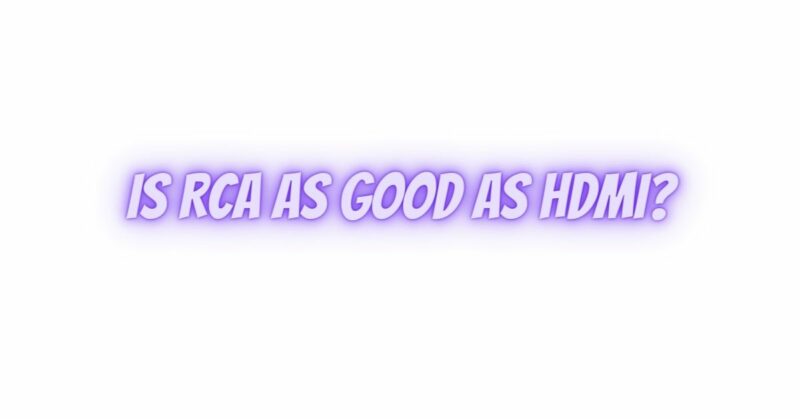The debate over whether RCA (Radio Corporation of America) is as good as HDMI (High-Definition Multimedia Interface) is a common one in the world of audio and video connectivity. These two standards serve different purposes and have distinct advantages and disadvantages. In this article, we’ll explore the differences between RCA and HDMI and discuss whether one is inherently better than the other.
RCA (Radio Corporation of America):
RCA connectors, also known as composite video connectors, have been a standard in audio and video equipment for decades. They are characterized by their red and white connectors for audio (right and left channels) and a yellow connector for video. Here are some key aspects of RCA:
1. Analog vs. Digital:
RCA is an analog format, which means it transmits audio and video signals as continuous electrical voltages. This analog nature can sometimes result in signal degradation and a lower overall quality compared to digital formats like HDMI.
2. Resolution and Quality:
RCA is capable of transmitting standard-definition video (480i) and stereo audio. It cannot support high-definition video or multichannel audio formats, limiting its use for modern high-quality audiovisual content.
3. Versatility:
RCA connectors are still commonly used for older devices, such as VCRs, DVD players, and some gaming consoles. They remain useful for connecting legacy equipment to older TVs and audio systems.
HDMI (High-Definition Multimedia Interface):
HDMI is a more recent and versatile standard for audio and video transmission. It has become the industry standard for modern home theater and multimedia systems. Here are some key aspects of HDMI:
1. Digital Clarity:
HDMI is an all-digital format, which means it transmits audio and video signals as binary data. This digital clarity ensures a high-quality, interference-free transmission, leading to superior audio and video performance.
2. High Definition and Beyond:
HDMI supports a wide range of video resolutions, including standard-definition, high-definition (720p and 1080p), and ultra-high-definition (4K and even 8K). It can carry both standard stereo audio and high-definition multichannel audio formats (e.g., Dolby TrueHD and DTS-HD Master Audio).
3. Versatility and Compatibility:
HDMI is compatible with virtually all modern audio and video devices, including HDTVs, Blu-ray players, gaming consoles, home theater receivers, and streaming devices. It offers a single cable solution for both audio and video, simplifying connections and reducing cable clutter.
4. Additional Features:
HDMI also supports various additional features, such as CEC (Consumer Electronics Control) for device synchronization, Ethernet over HDMI for internet connectivity, and ARC (Audio Return Channel) for sending audio from the TV to a receiver.
Conclusion:
In a direct comparison, HDMI is generally considered superior to RCA in terms of audio and video quality, versatility, and compatibility with modern equipment. RCA connectors are still relevant for older devices and certain applications but are limited in terms of resolution and audio capabilities.
Ultimately, whether RCA or HDMI is “better” depends on your specific needs and the devices you’re connecting. If you’re working with modern high-definition equipment and want the best audiovisual experience, HDMI is the clear choice. However, if you’re dealing with older devices or specific audio setups, RCA connectors may still have a place in your setup. In many cases, you may find yourself using both standards to accommodate different devices and situations.


